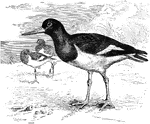
European Oyster-catcher
"Haematopus ostrilegus. European Oyster-catcher. (oyster-opener would b a better name, as oysters do…
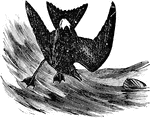
Leach's Petrel
"Cymochorea leucorrhoa. Leach's Petrel. White-rumped Petrel. Coloration as in the last species (pygmy…
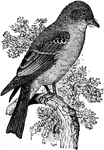
Wood Pewee
"Contopus virens. Wood Pewee. Olivaceous-brown, rather darker on head; with sides washed with a paler…

Wilson's Phalarope
"Steganopus wilsoni. Wilson's Phalarope. Bill and feet black. Crown of head pale ash, passing into white…
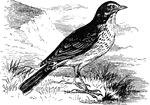
Meadow Pipit
"Meadow Pipit or Anthus pratensis. Upper parts greenish-brown distinctly marked with blackish-brown…
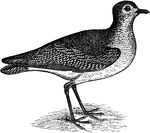
American Golden Plover
"Charadrius dominicus. American Golden Plover. Field Plover. Bull-head Plover. Upper parts black, everywhere…
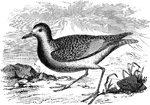
Black-bellied Plover
"Squatarola helvetica. Swiss Plover. Black-bellied Plover. Bull-head Plover. Whistling Field Plover.…
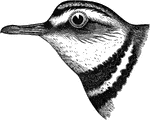
Kildeer Plover
"Aegialites vociferus. Kildeer Plover. Above, grayish-brown, with an olive shade, and in high plumage…
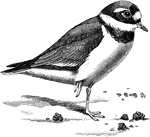
Ringed Plover
"Aegialitis hiaticola, the Ringed Plover, Sand-Lark, or Stone-runner, mistakenly called the "Ring-Dotterel"…
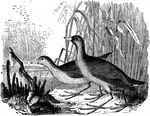
Carolina Rail
"Porzana carolina. Carolina Crake. Common Rail. "ortolan." Above, olive-brown, varied with black, with…
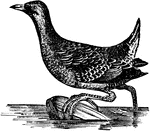
Small Carolina Rail
"Porzana carolina. Carolina Crake. Common Rail. "ortolan." Above, olive-brown, varied with black, with…
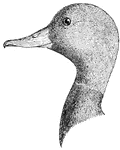
Large Redhead
"Fuligula ferina americana. Red-head. American Pochard. The feathers of the head somewhat full and puffy,…
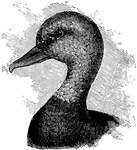
Small Redhead
"Fuligula ferina americana. Red-head. American Pochard. The feathers of the head somewhat full and puffy,…
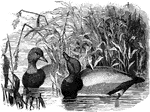
Redheads
"Fuligula ferina americana. Red-head. American Pochard. The feathers of the head somewhat full and puffy,…
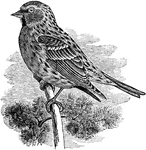
Common Redpoll
"Aegiothus linaria. Common Redpoll. Common Red-poll. Frontlet, lores, and throat-spot sooty-black. Crown…
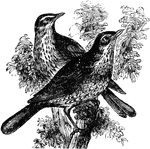
European Redwing
Two European Redwing birds sitting on a tree branch. These song birds are usually brown with darker…
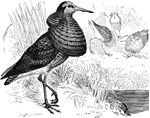
Ruff
"Machetes pugnax. Ruff. Reeve. Combatant. Gambetta. Varied above with black, brown, buff and chestnut,…
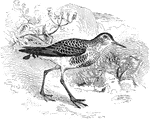
Sanderling
"Calidris arenaria. Sanderling. Ruddy "Plover". Adult in summer: Entire upper parts and neck all round…

Buff-breasted Sandpiper
"Tryngites rufescens. Buff-breasted Sandpiper. Above, brownish-black with a greenish gloss, every feather…

Solitary Sandpiper
"Rhyacophilus solitarius. Solitary Tattler. American Green Sandpiper. Solitary Sandpiper. Above, dark…
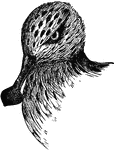
Spoon-billed Sandpiper
"Eurynorhynchus pygmaeus. Spoon-billed Sandpiper. General appearance of a stint, and size little greater.…

Spotted Sandpiper
"Tringoides macularius. Spotted Sandpiper. Above, silken ashen-olive (quaker-color- as in our cuckoos)…
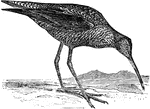
Stilt Sandpiper
"Micropalama himantopus. Stilt Sandpiper. In summer: blackish, each feather edged and tipped with white…

Black Scoter
"Oidemia americana. American Black Scoter. Sea Coot. Adult male: Plumage entirely black, less glossy…

Sooty Shearwater
"Puffinus fuliginosus. Sooty Shearwater. Nearly uniform dark sooty-brown, blackening on quills and tail-feathers,…
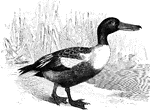
Northern Shoveler
"Spatula clypeata. Shoveller Duck. Broad-bill. Bill blackish; iris orange-red: feet vermilion-red. Head…
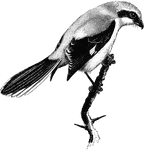
Great Grey Shrike
"The Lanius excubitor, Great Grey Shrike, lax plumage is either black, grey, and white, or is varied…
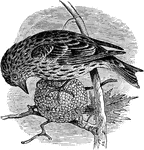
Pine Siskin
"Carduelis pinus. Pine Linnet. Pine Finch. American Siskin. Pine Siskin. Continuously streaked, above…
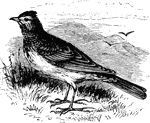
Skylark
"Sky-Lark. Upper parts grayish-brown, the feathers with darker centers; under parts whitish, tinged…
Red-breasted Snipe Head
"Macrorhamphus griseus. Red-breasted Snipe. Gray Snipe. Brown-back. Dowitcher. In summer:Under parts…
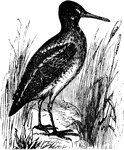
English Snipe
"Gallinago media. European Snipe. English Snipe. In size, form, and general coloration indistinguishable…
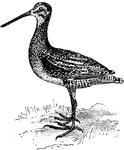
Small Wilson's Snipe
"Gallinago wilsoni. American Snipe. Wilson's Snipe. "English" Snipe. Jack-Snipe. Crown black, with a…
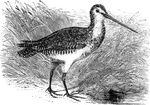
Wilson's Snipe
"Gallinago wilsoni. American Snipe. Wilson's Snipe. "English" Snipe. Jack-Snipe. Crown black, with a…
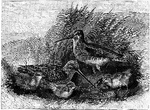
Family of Snipes
"Gallinago wilsoni. American Snipe. Wilson's Snipe. "English" Snipe. Jack-Snipe. Crown black, with a…
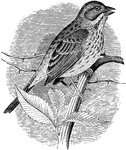
Song Sparrow
"Melospiza fasciata. Song Sparrow. Silver-tongue. Below, white, slightly shaded with brownish on the…
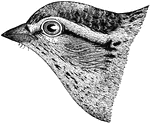
Chipping Sparrow Head
"Spizella domestica. Chipping Sparrow. Chipping Bird or Chippy. Hair-bird. Bill black; feet pale; crown…
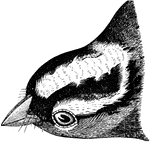
White-crowned Sparrow Head
"Zonotrichia leucophrys. White-browned Crown Sparrow. Crown pure white, enclosing on either side a broad…
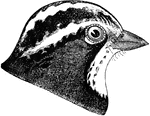
White-throated Sparrow Head
"Zonotrichia albicollis. White-throated Crown Sparrow. Peabody-bird. Crown black divided by a median…
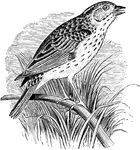
Baird's Sparrow
"Passerculs bairdi. Baird's Savanna Sparrow. Inner secondaries less elongated, rarely equaling the primaries…
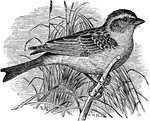
Chipping Sparrow
"Spizella domestica. Chipping Sparrow. Chipping Bird or Chippy. Hair-bird. Bill black; feet pale; crown…
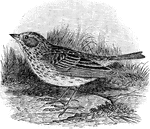
Common Savanna Sparrow
"Passercules s. savana. Common Savanna Sparrow. Thickly streaked everywhere above, on sides, and across…
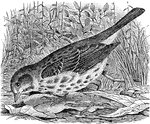
Fox Sparrow
"Passerella iliaca. Eastern Fox Sparrow. General color above ferrugineous or rusty-red, purest and brightest…
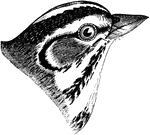
Lark Sparrow
"Chondestes grammica. Lark Sparrow. Lark Finch. Head variegated with chestnut, black, and white; crown…
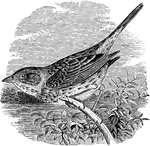
Lincoln's Sparrow
"Melospiza lincolni. Lincoln's Song Sparrow. Below, white, with a broad brownish-yellow belt across…
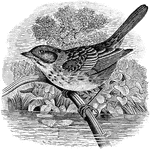
Swamp Sparrow
"Melospiza palustris. Swamp Song Sparrow. Crown bright chestnut, blackening on forehead, the red cap…
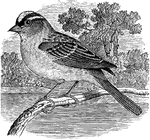
White-crowned Sparrow
"Zonotrichia leucophrys. White-browned Crown Sparrow. Crown pure white, enclosing on either side a broad…
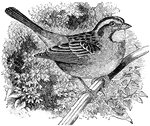
White-throated Sparrow
"Zonotrichia albicollis. White-throated Crown Sparrow. Peabody-bird. Crown black divided by a median…

Yellow-winged Sparrow
"Coturniculus passerinus. Yellow-winged Sparrow. Quail Sparrow. Grasshopper Sparrow. Edge of wing conspicuously…
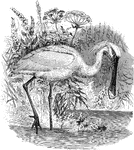
European Spoonbill
"European Spoonbill. Platalea leucorodia. Bill long, flat, remarkably widened, rounded, and spoon-shaped…

Starling
"Sturnus vulgaris. The Starling. Adult: General plumage of metallic lustre, iridescing dark green on…
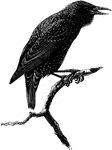
Common Starling
"Our familiar Starling (Sturnus vulgaris) being iridescent black, with buff markings above, and, after…
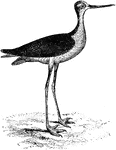
Stilt
"Himantopus. Stilts. Bill extremely slender, but not flattened, nor turned up, nor hooked; longer than…

Black-necked Stilt
"Stilt. Long-shanks. Lawyer. Adult. Mantle, constituted by the interscapulars, scapulars, and wings…
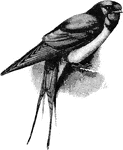
Swallow
"Hirundo rustica, the Swallow, is metallic black, with a variable amount of chestnut or rufous on the…

Martin and Swallow
"Cotile riparia. Bank Swallow. lustreless mouse-brown; wings and tail fuscous. Below, white, with a…
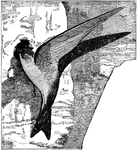
Bank Swallow
"Cotile riparia. Bank Swallow. lustreless mouse-brown; wings and tail fuscous. Below, white, with a…
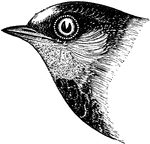
Cliff Swallow
"Cliff Swallow. Eaves Swallow. Crescent Swallow. Mud Swallow. back and top of head, with a spot on the…
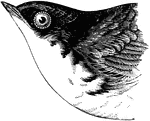
White-belied Swallow
"Entire upper parts glossy dark green; wings and tail blackish, lustrous; lores black. Entire under…
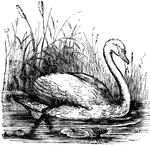
Mute Swan
"Cygynus. White Swans. Neck of extreme length. Trachea normally entering sternum. Bill tuberculate or…
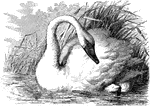
Whistling Swan
"Cygnus columbianus. Common American Swan. Whistling Swan. Bill with a yellow spot or blotch in front…